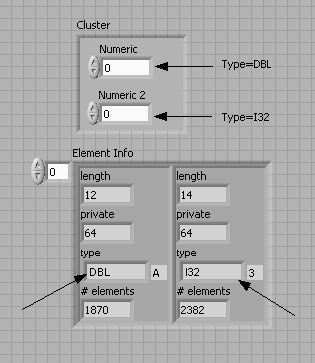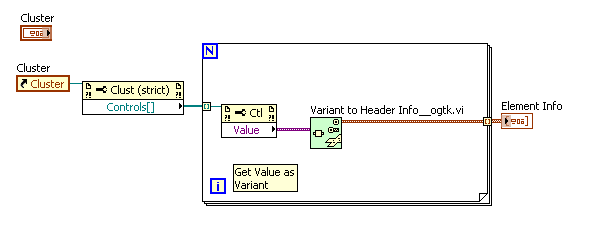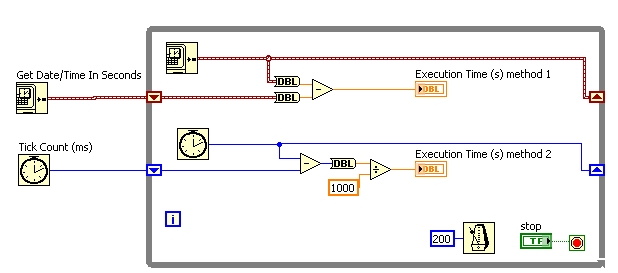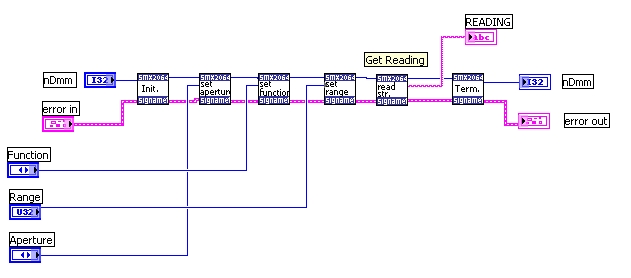-
Posts
108 -
Joined
-
Last visited
Content Type
Profiles
Forums
Downloads
Gallery
Posts posted by Karissap
-
-
QUOTE (marp84 @ May 10 2008, 11:57 AM)
This sounds like a similar assignment to this http://www.ese.upenn.edu/rca/software/Labview/Cardiacvi/cardiacvi.html' rel='nofollow' target="_blank">Cardiac Monitor LabVIEW project
Basically LabVIEW can do PC transfer methods such as TCP, UDP, FTP,SMTP email or you can use Bluetooth, serial communication etc, the possibilities are endless.
You'll get better responses if you show what you've tried already by posting your code or by asking more specific LabVIEW questions if you get stuck.
-
If you just care about the type of data including differentiating the type of numeric DBL, I32 etc have a look at the Open G VI "Variant to Header Info". See the attached front panel and block diagram.
If you want to handle clusters or arrays in clusters etc you will need to add recursion.
-
QUOTE
1.What is MAX (Measurement and automation explorer)?Basically it is a program for managing all devices, interfaces and software supported by National Instruments.
QUOTE
(From this i can notice the instruments which are connected through GPIB!)Yes. Expand the devices and interfaces configuration and you should see your GPIB instruments, if not the NI-488.2 software might not be properly installed
QUOTE
2.Can this MAX can show me the instruments list which are connected RS232,USB..ETC. also?It will show you instruments connected under RS232 and USB only if they are NI products or supported by NI.
I have several NI USB devices I configure with MAX.
It also provides a generic RS232 IO utility
QUOTE
3.Why we need to install MAX separately?Because it is a seperate software utility program
QUOTE
4.what are the features it has for us?It can help you troubleshoot and calibrate instruments, provide an overview of what is connected to the system and what driver versions are in use.
You can also setup DAQmx scales, channels and tasks.
QUOTE
4.What are the difficulties we will face without MAX?Max is a great utility if you are using NI hardware products. You might have more difficulty troubleshooting instrument errors etc and configuring NI hardware without it.
QUOTE
5.What is NI-DAQmx and how we can differentiate from MAX?NI-DAXmx is drivers and software API for newer NI Data Acquisition devices See Getting Started with NI-DAQmx
-
QUOTE(tcplomp @ Nov 8 2007, 06:52 PM)
You have to keep the reference open.The buffer size will determine how often data is written to disk while streaming. A high number will lower the disc activity but a power failure will throw away more items.
With a low number your TDMS file needs more defragmentation afterwards.
On closing the TDMS file the whole buffer will be written to disc
Ton
Thanks, it's working great now. I also had the problem that it wasn't working in 8.20. I had to save the whole project to 8.5.
-
Can anyone give me an example of how to use the buffer property of TDMS files? I have tried setting NI_MinimumBufferSize to a value like 1000 using TDMS Set Properties.vi but it doesn't seem to be working. If you use the buffer do you have to leave the file open in between writes and not use close. Also, how does the write buffer affect reading the TDMS data?
-
I am doing this in one of my applications by showing or hiding pages in a tab control. It make things a lot easier to remove or add access to a lot of controls at once.
Here's an example:
-
I created this example in the code repository USB continuous acquire I used a Logitech webcam. At the time when I created it I didn't have the vision toolkit, I only used the free IMAQ drivers and the free NI IMAQ for USB drivers.
-
If you want to know the execution time your while loop takes you can use a shift register to calculate the difference in time. Here is an example using "Get Date/Time in Seconds.vi" and "Tick Count (ms).vi". The method that uses the get date/time will use more processor time than the tick count method. However, if you use the tick count method the counter will wrap back around to zero at some point so you will get an error eventually if you run it for a long time (will wrap around once every 50 days).
Download File:post-8228-1193724740.vi
I don't know if this is what you are after or if you wanted help using the timed-loop structure.
-
The example "calling System Exec.vi" should only open notepad once. It does on my computer. Are you sure you pressing the run button in the toolbar and not run continuously?
-
The exec.vi doesn't keep opening the application, check that you haven't put it in a loop.
You can also use activex methods to open word, do document control and close it afterwards. There are examples included in LabVIEW that show how to do this. Search for excel or word. There's also the Report Generation Toolkit from NI.
This file might also help word97_activex.zip
It should still work for a newer version of word.
-
You can try these Sample Exams (Traffic Light, Car wash and Security System) available on the ni site for problems that are at the intermediate level. There's also a free CLD prepatation webcast which is a 30 minute video going through a lot of the intermediate concepts.
If you think of programs you want to make for yourself or for work you will probably end up using things like event structures and dlls anyway. I passed the CLD exam without looking at any of the intermediate course material as I had used the intermediate concepts in projects already and Basics I and II gave me good general LabVIEW programming and documentation practices etc.
-
I'm using the SM2064 which is the PCI version which uses the same drivers. Have you tried using the LabVIEW drivers available from the manufacturer? There is an example vi SMX2064 Read Example.vi which might be useful. Shown below is a screenshot of the basic functions used to get a measurement.
Make sure your aperture is not set to small and the range is valid for the function you are using. The user manual is really good and comprehensive. Also check the calibration file exists and has the correct data in it (usually at C:\Sm60cal.dat). Otherwise, the support engineers at Signametrics have been very helpful to me in the past.
-
QUOTE(alukindo @ Sep 19 2007, 02:52 AM)
Was checking LabVIEW settings which will allow tabbing to a check-box and toggle TRUE/FALSE value by pressing <RETURN KEY>.
To toggle the true/false value you can right click on the button, go to properties then the Key Navigation Tab and in the toggle section choose "Return" from the drop down list.
You can set the tabbing order of front panel objects by selecting Edit»Set Tabbing Order
-
-
See this thread for some discussion about the system tray, there are some commercial LabVIEW libraries around like INVtray and gtoolbox
You should be able to do it yourself though with windows dlls or active x.
Here is a good tutorial on using srvany.exe to create services.
-
I'm not aware of a straight forward way to write to stdout from a labview exe.
I got some information from this thread though on the ni forums.
You could use windows system dll calls to write to stdout:
QUOTE
For the output...Use GetStdHandle, kernel32 to get a handle, (handle GetStdHandle(long
param), use -11 for parameter);
Use WriteFile, kernel32 to write a string (long WriteFile(long handle, CStr
message, long length, long *written, long overlapped));
This is pretty advanced to do this though if you haven't had much experience calling dlls from LabVIEW.
If you are able to create files somewhere I suggest the method described at the beginning of the thread:
QUOTE
Have the VI save its output to a file and then use the DOS command type to put the data on the command line. The command to call the VI and retreive the results could be put in a *.bat file. -
QUOTE(tum @ Aug 23 2007, 12:08 PM)
Here is a screenshot after I built the vi I posted before into an executable C:\application.exe.
http://forums.lavag.org/index.php?act=attach&type=post&id=6724''>http://forums.lavag.org/index.php?act=attach&type=post&id=6724'>http://forums.lavag.org/index.php?act=attach&type=post&id=6724
-
You can use this method in earlier versions such as LabVIEW 7.1 as well, it is just an application property node in the vi.
Here is a vi that gets the command line arguments in LabVIEW version 7.1
http://forums.lavag.org/index.php?act=attach&type=post&id=6698
http://forums.lavag.org/index.php?act=attach&type=post&id=6697
-
I've used C DLLs in LabVIEW many times you basically need a Call Library Function Node and double click to set up the parameters acording to the API. If the dll came with a header file there is a wizard which can generate dlls automatically in 8.2 its is found under "Tools>>Import>>Shared Library(.dll)" in the menu. Here is a full Manual which might be helpful: Using External Code in LabVIEW Manual
I have a canon A620 so would be interested in this project. Where did you get the dll from?
-
I got the same value of 0.015625 seconds for every loop execution when I ran your test. There are a whole bunch of things which can improve vi timing. Something like a Timed Loop sounds like it would be better for your application. Try searching for timed-loop in the example finder.
http://forums.lavag.org/index.php?act=attach&type=post&id=6474
-
QUOTE(MK07 @ Jul 26 2007, 06:50 PM)
I see you are using a LabVIEW version 8.2.1 so here is some help based on that. You can create an exe and installer if you have the LabVIEW Professional Version not base or full, you might need to upgrade. (LabVIEW Options)
If you have the professional version, you need to have your VIs in a project. Then just right right click on build specifications in the project explorer window and choose exe and fill out all the options. Do the same for an installer, you can only create an installer once you have created and exe though.
QUOTE(MK07 @ Jul 26 2007, 06:50 PM)
and how to i connect GBIB device with labview?? if any example please provide me..What GPIB instrument are you using? Most instruments with a GPIB connection have instrument drivers that makes communication easy, to find drivers you can selecting "Help >> Find Instrument Drivers..." from the menu.
Otherwise just look at the instrument manufacturer's website or contact them.
There is also an Instrument IO assistant express VI you can use to enter GPIB commands directly. Just use the programming guide in your instrument's manual to find the instructions you need.
-
You could use a program like wget
It will be able to download pdfs from the internet.
You could call it from the command line using System Exec.vi
-
Thanks everyone, exactly what I was after and thanks for the extra hints as well, I think they'll come in handy
 .
. -
I was wondering if anyone knew how to change the visibility of 3d graph cursors programmatically, there must be a way to do it seeing as it can be changed in the properties dialog box, it's probably private but since when has that stopped anyone
 .
. http://forums.lavag.org/index.php?act=attach&type=post&id=6431
The only property node I can find for 3d graph cursors is count, and it's read only.
It would be great if I could read the cursor position programmatically too.








Custom Install Reboot and Resume Option
in Application Builder, Installers and code distribution
Posted
I use Inno Setup to create installers for some LabVIEW programs, I've found it really good to use plus it's free but you could certainly use one of the others.
As for a batch file to restart and resume, there is an option to run a program after the installation in the default LabVIEW installer creator. To resume the installation on reboot I would use the "RunOnce" registry key under HKLM/Software/Microsoft/Windows/CurrentVersion, so the program will only run once AFTER reboot, and then windows will remove the entry from your the registry http://support.microsoft.com/kb/179365
Alternatively you could create a shortcut in the startup folder of the start menu that gets deleted after installation if you don't want to use the registry.
To actually restart the computer use the "shutdown -r" command in the batch file, you can use other options to display prompts and timers etc.